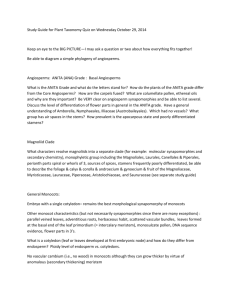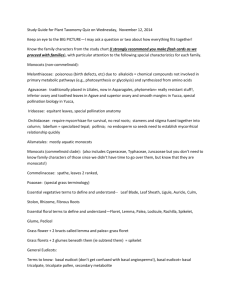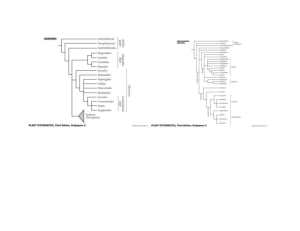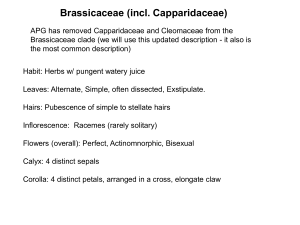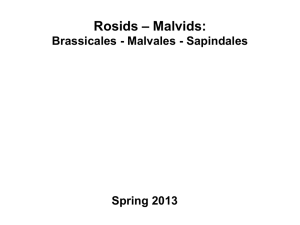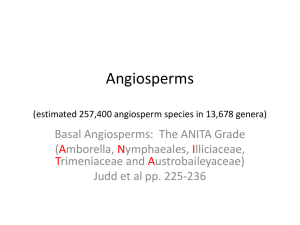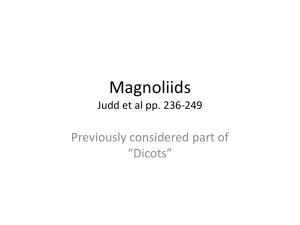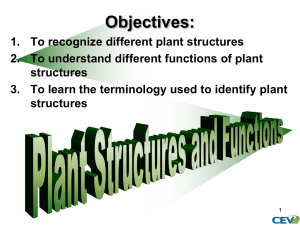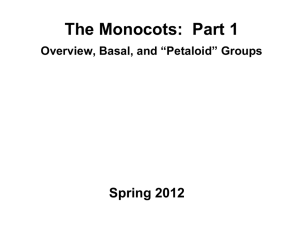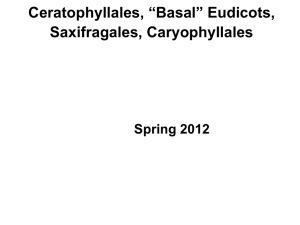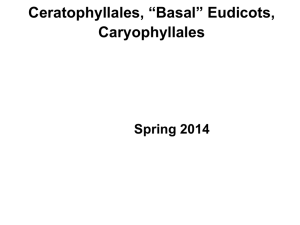Study Guide for Quiz on Wednesday November 4
advertisement
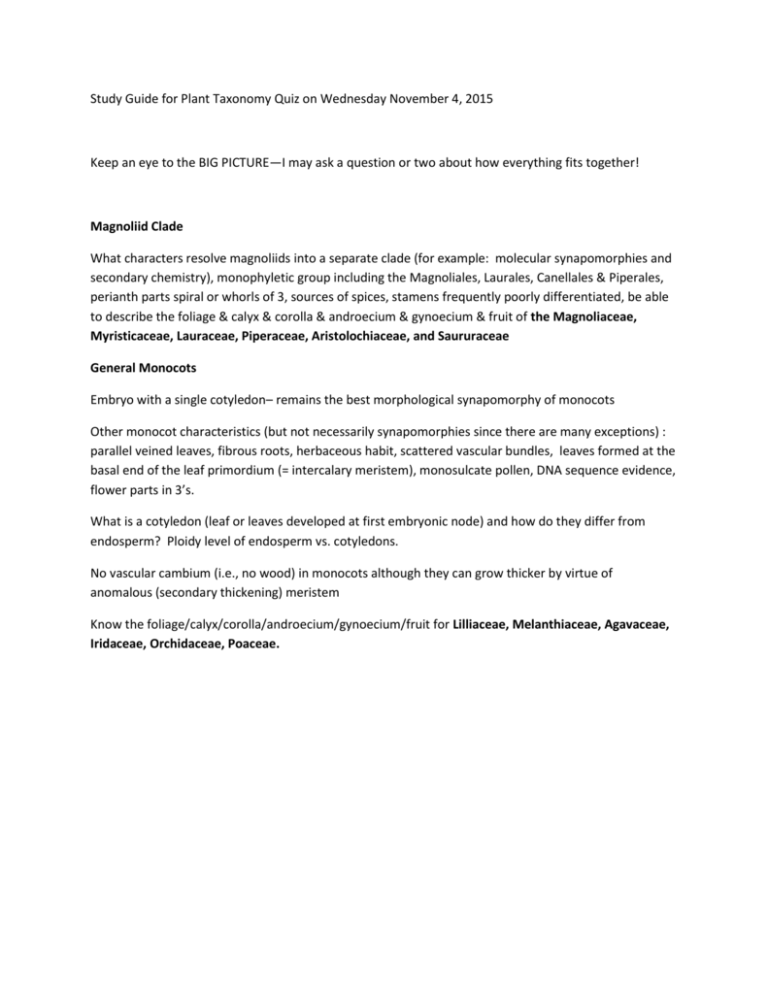
Study Guide for Plant Taxonomy Quiz on Wednesday November 4, 2015 Keep an eye to the BIG PICTURE—I may ask a question or two about how everything fits together! Magnoliid Clade What characters resolve magnoliids into a separate clade (for example: molecular synapomorphies and secondary chemistry), monophyletic group including the Magnoliales, Laurales, Canellales & Piperales, perianth parts spiral or whorls of 3, sources of spices, stamens frequently poorly differentiated, be able to describe the foliage & calyx & corolla & androecium & gynoecium & fruit of the Magnoliaceae, Myristicaceae, Lauraceae, Piperaceae, Aristolochiaceae, and Saururaceae General Monocots Embryo with a single cotyledon– remains the best morphological synapomorphy of monocots Other monocot characteristics (but not necessarily synapomorphies since there are many exceptions) : parallel veined leaves, fibrous roots, herbaceous habit, scattered vascular bundles, leaves formed at the basal end of the leaf primordium (= intercalary meristem), monosulcate pollen, DNA sequence evidence, flower parts in 3’s. What is a cotyledon (leaf or leaves developed at first embryonic node) and how do they differ from endosperm? Ploidy level of endosperm vs. cotyledons. No vascular cambium (i.e., no wood) in monocots although they can grow thicker by virtue of anomalous (secondary thickening) meristem Know the foliage/calyx/corolla/androecium/gynoecium/fruit for Lilliaceae, Melanthiaceae, Agavaceae, Iridaceae, Orchidaceae, Poaceae. Family Magnoliid Clade Magnoliaceae Myristicaceae Lauraceae Piperaceae Foliage Calyx Corolla Androecium Gynoecium Fruit Trees/shrubs blade with pellucid dots containing ethereal oils (aromatic terpenoids) bark exudes reddish sap; blades with pellucid dots containing ethereal oils; contains myristicin (=hallucinogen Tepals distinct Tepals distinct Many undifferentiated stamens Numerous distinct, superior aggregate of follicles, seed red, dangles Three connate tepals Three connate tepals filaments connate into a solid column; stamens 2 to numerous one ovule, ovary superior leathery follicle, large seed, colorful aril contain ethereal oils (made from 5 carbon fragment called terpenoid) contains Usually 6 tepals Usually 6 tepals filaments with nectar producing appendages; stamens 3-12 one carpel, ovary superior Drupe or one seeded berry No No filaments 1 ovule per drupe ethereal oils Aristolochiaceae ethereal oils with pellucid dots and aristolochic acids, bitter yellow nitrogenous compounds Saururaceae with ethereal oils Family perianth! Spikes of thick, minute flowers connate, showy, dull red, mottled perianth! Spikes of thick, minute flowers missing distinct; stamens 1-10 gynoecium, superior filaments adnate to style; stamens 6-12 4-6 carpels, inferior ovary Septicidal capsule Absent-Flowers with a single petaloid bract Absent-Flowers with a single petaloid bract 3-8 distinct stamens 3-4 carpels united at the base; superior capsule Foliage Calyx Corolla Androeciu m Gynoeciu m Fruit bulbs or rhizomes, parallel venation Six distinct tepals Six distinct tepals Stamens 6, filaments distinct 3 connate carpels, ovary superior Loculicidal capsule Melanthiacea e poisonous alkaloids often present (hence the “Death Camas Family”!) 6 mostly distinct tepals 6 mostly distinct tepals usually 6 distinct stamens capsule Agavaceae leaves smooth with marginal fibers in Yucca; leaves toothed in 6 distinct tepals 6 distinct tepals 6 distinct stamens 3-10 connate carpels, usually 3 distinct styles; superior to slightly inferior 3 connate carpels; ovary superior in Yucca, inferior in Agave Monocots (nonCommelinoid Clade) Liliaceae loculicidal capsule, seeds with black phytomelan crust Iridaceae Orchidaceae Family Monocots (Commelinoid Clade) Commelinaceae Poaceae Agave Equitant (& conduplicat e) Roots strongly mycorrhizal, parallel venation and sheathing at the base 6 tepals, inner somewhat differentiate d from outer 6 tepals, inner somewhat differentiate d from outer 6 Tepals, inner 3 and outer 3 somewhat differentiate d, one of the inner ones forming the labellum 6 Tepals, inner 3 and outer 3 somewhat differentiate d, one of the inner ones forming the labellum Three distinct filaments, specialized pollination anatomy stamens fused to stigma forming a column; pollen forming masses called pollinia Three connate carpels, inferior ovary Loculicidal capsule ovary inferior, 3 carpels, stigma highly modified capsule/minut e seeds; seeds lacking endosperm Foliage Calyx Corolla Androecium Gynoecium Fruit Grass like, sheathing at the base; flowers enclosed in spathe sometimes Divided into blade and sheath; ligule at junction; sometimes with auricle; stem=culm Three, distinct Three distinct, usually clawed Ovary superior, 3 connate carpels Special flower anatomy c/o flower, floret, lemma, palea, glumes, lodicule, etc. Special flower anatomy c/o flower, floret, lemma, palea, glumes, lodicule, etc. 3 or 6 stamens, sometimes with conspicuous hairs (Tradescantia) 3 distinct stamens Loculicidal capsule; seeds with conspicuous conical cap, bullet shaped Grain= caryopsis Plant Taxonomy Plant ID list 2015: Euphorbia (term to know: cyathium) in the EUPHORBIACEAE 3 superior carpels that appear as two but only produce one grain Tribulus (terms to know: schizocarp, actinomorphic vs. zygomorphic=bilateral symmetry) in the ZYGOPHYLLACEAE Chamaesyce (terms to know: serrate, pubescent) in the EUPHORBIACEAE Ipomopsis (term to know: exserted) in the POLEMONIACEAE Sphaeralcea (term to know: monadelphous) in the MALVACEAE Hesperidanthus (terms to know: tetradynamous, silique, clawed petal) in the BRASSICACEAE Phaseolus (term to know: keel= 2 fused petals, papilionaceous) in the FABACEAE Guilleminea in the AMARANTHACEAE Helianthus (terms to know: phyllary, Involucre) in the ASTERACEAE Juncus (term to know: rhizome vs. stolon) in the JUNCACEAE Castilleja (terms to know: hemiparasite vs. holoparasite) in the OROBANCHACEAE Boerhavia (term to know: involucre) in the NYCTAGINACEAE Croton (term to know: dioecious) in the EUPHORBIACEAE Solanum (term to know: sympetalous) in the SOLANACEAE Mentha (term to know: anthocyanins) in the LAMIACEAE Berula (term to know: umbel) in the APIACEAE Anemopsis (term to know: Magnoliid) in the SAURURACEAE Verbena in the VERBENACEAE Kochia (term to know: betalains) in the CHENOPODIACEAE Argemone (term to know: caducous) in the PAPAVERACEAE Polanisia in the CLEOMACEAE Eriogonum in the POLYGONACEAE Lepidium in the BRASSICACEAE Phoradendron in the SANTALACEAE Froelichia in the AMARANTHACEAE Ephedra (term to know: Gnetophyte) in the EPHEDRACEAE Vitis in the VITACEAE (term to know: tendril) Crotalaria in the FABACEAE Kraschenninikovia in the CHENOPODIACEAE Ptelea in the RUTACEAE (terms to know: pellucid dots, ethereal oils) Drymaria in the CARYOPHYLLACEAE Ambrosia in the ASTERACEAE
